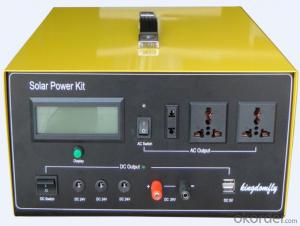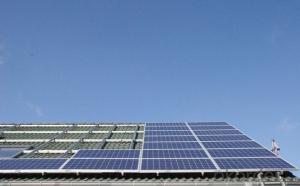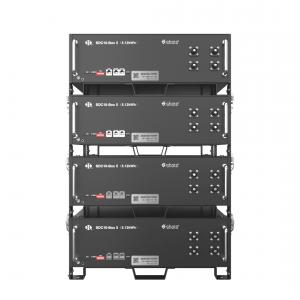Skagit Solar Energy Systems:15kw Solar Home Solution with 25 Years Quality Assurance
- Loading Port:
- Shanghai
- Payment Terms:
- TT OR LC
- Min Order Qty:
- 1 pc
- Supply Capability:
- 5000 pc/month
OKorder Service Pledge
OKorder Financial Service
You Might Also Like
Specification
15KW Solar Home Solution with 25 years Qualtiy Assurance
Production description
a solar array only encompasses the ensemble of solar panels, the visible part of the PV system, and does not include all the other hardware, often summarized as balance of system (BOS). Moreover, PV systems convert light directly into electricity and shouldn't be confused with other technologies, such as concentrated solar power or solar thermal, used for heating and cooling.

Feature
1.High conversion efficiencies resulting in superior power output performance.
2.Outstanding power output even in low light or high temperature conditions
3.Optimized design for ease of soldering and lamination
4.Long-term stability,reliability and performance
5.Low breakage rate
6.Color uniformaity
Physical characteristic
1. Rigorous quality control meets the highest international standards.
2. High-transmissivity low-iron tempered glass, strong aluminium frame.
3. Using UV-resistant silicon.
4. IS09001/14001/CE/TUV/UL
- Q: What is the impact of solar energy systems on reducing energy poverty?
- The provision of affordable and sustainable electricity to communities lacking reliable access to traditional power grids is significantly impacted by solar energy systems. One of the primary benefits of such systems is their ability to generate electricity from sunlight, which is abundant in many parts of the world. This allows for the installation of solar energy systems even in remote and underserved areas, thereby reducing dependence on expensive and polluting fossil fuels. Solar energy systems harness the power of the sun to bring electricity to rural households, schools, and healthcare facilities that previously relied on costly and unreliable alternatives like kerosene lamps or diesel generators. This not only improves the quality of life for individuals and communities but also facilitates economic development by granting access to modern technologies and opportunities. Additionally, solar energy systems contribute to the reduction of energy poverty through the provision of a stable and dependable energy source. Due to their minimal maintenance requirements and long lifespan, solar panels can continue generating electricity for many years, minimizing the risk of power outages and ensuring a consistent energy supply. Furthermore, solar energy systems empower communities by enabling them to become energy-independent and self-sufficient. By installing solar panels on rooftops or utilizing solar-powered mini-grids, communities can generate their own electricity and decrease reliance on centralized energy systems. This not only enhances energy security but also creates income-generating opportunities through the sale of excess electricity back to the grid. In conclusion, solar energy systems play a vital role in reducing energy poverty by providing affordable and sustainable electricity to underserved communities. They enhance quality of life, foster economic development, and empower communities to become self-reliant. By leveraging the abundant and renewable energy of the sun, solar energy systems have the potential to transform the lives of millions of people and alleviate energy poverty on a global scale.
- Q: Can solar energy systems be used for powering data centers or IT infrastructure?
- Yes, solar energy systems can definitely be used to power data centers or IT infrastructure. Solar energy is a renewable and sustainable source of power that can be harnessed through photovoltaic (PV) panels. By installing solar panels on the roofs or other suitable areas of a data center, companies can generate electricity from the sun and use it to power their IT infrastructure. This not only reduces reliance on traditional energy sources but also helps in minimizing carbon emissions and operating costs. Additionally, advancements in energy storage technologies allow for solar power to be used even during non-sunlight hours, ensuring uninterrupted power supply to data centers.
- Q: What are the environmental benefits of using solar energy systems?
- Solar energy systems offer several environmental benefits. Firstly, solar energy is constantly replenished by the sun, making it a renewable source that will never run out. This is in stark contrast to finite resources like coal or oil that contribute to the depletion of our planet's natural resources. Another significant environmental benefit of solar energy is its minimal greenhouse gas emissions. Compared to traditional energy sources such as coal or natural gas, solar energy systems produce significantly lower levels of carbon dioxide and other pollutants harmful to the environment. By reducing our reliance on fossil fuels and transitioning to solar power, we can mitigate the adverse effects of climate change and improve air quality. Furthermore, solar energy systems have a smaller ecological footprint compared to other forms of energy generation. The extraction and transportation of fossil fuels often result in habitat destruction, soil erosion, and water pollution. On the other hand, solar panels have a relatively low impact on the environment during their manufacturing process and do not require ongoing extraction or transportation of fuel. Solar energy systems also offer the advantage of decentralization. Unlike large-scale power plants that rely on extensive transmission infrastructure, solar panels can be installed on rooftops, reducing the need for long-distance energy transportation. This not only decreases energy loss during transmission but also helps protect natural habitats from disruption caused by the construction of power lines. Finally, the use of solar energy systems can contribute to energy independence. By harnessing the power of the sun, individuals, communities, and even entire countries can reduce their reliance on imported energy resources. This reduces vulnerability to price fluctuations and supply disruptions associated with fossil fuels, promoting energy security and stability. In conclusion, the environmental benefits of solar energy systems are numerous and significant. From being a renewable source of energy and reducing greenhouse gas emissions to minimizing ecological footprints and promoting energy independence, solar power offers a sustainable and responsible alternative to traditional energy sources.
- Q: Can solar energy systems be integrated into existing electrical systems?
- Yes, solar energy systems can be integrated into existing electrical systems. By installing solar panels on rooftops or other suitable locations, the generated electricity can be fed into the existing electrical system, reducing the reliance on traditional sources of electricity and potentially lowering energy costs. However, it is important to ensure the compatibility and capacity of the existing electrical infrastructure to handle the additional power supply from the solar energy system.
- Q: Can solar energy systems be used in areas with limited access to solar energy maintenance services?
- Yes, solar energy systems can still be used in areas with limited access to solar energy maintenance services. While regular maintenance and servicing are important for optimal performance and longevity of solar energy systems, advancements in technology have made them more durable and self-sufficient. Additionally, training programs and remote monitoring services are available to help individuals in such areas troubleshoot and maintain their systems effectively. With proper education and support, communities with limited access to maintenance services can still benefit from solar energy.
- Q: What is the role of batteries in solar energy systems?
- The role of batteries in solar energy systems is to store excess electricity generated by solar panels for use during times of low or no sunlight. This allows for constant power supply and enables the system to operate independently from the grid, increasing self-sufficiency and reliability.
- Q: How to calculate the income of photovoltaic system
- Photovoltaic panels can only generate electricity, storage batteries need to match. The peak power output of photovoltaic panels = peak wattage X local sunshine time X efficiency coefficient of general domestic parts of the sunshine time is 4 hours (per day), the efficiency of PV system with battery is about 0.7. That is to say, 1000W system, the average daily electricity is about 2800WH (2.8 degrees) or so in accordance with the distributed PV subsidy of 0.35 yuan / degree, solar photovoltaic power generation more than the Internet how exactly?
- Q: Are there any risks of theft or vandalism with solar energy systems?
- Solar energy systems do come with some risks of theft or vandalism. Valuable solar panels and equipment used in these systems can attract thieves who may try to sell them on the black market. Moreover, since solar energy systems are usually installed in remote or isolated areas, they are more susceptible to theft as they may not be easily monitored. Vandalism is also a concern as solar panels can be intentionally damaged or destroyed by individuals with a grudge against the owner or simply for the sake of causing damage. This can result in financial loss and disruption of energy production. To mitigate these risks, homeowners and businesses can take various precautions. Installing security measures like surveillance cameras, motion sensors, or alarms can deter theft or vandalism. Placing panels in visible and easily accessible locations can also make them less appealing to potential thieves. Additionally, marking the panels with unique identifiers can make it harder for thieves to sell them. Insurance coverage is another crucial consideration to safeguard against theft or vandalism. Many insurance companies offer specialized policies that cover solar energy systems, providing compensation in case of theft or damage. In summary, although there are risks of theft or vandalism associated with solar energy systems, these risks can be minimized through preventive measures and insurance coverage. It is important for owners of solar energy systems to be aware of these risks and take appropriate steps to safeguard their investment.
- Q: Do solar panels work on cloudy days?
- Yes, solar panels do work on cloudy days, although their efficiency may be reduced compared to sunny days. While they generate less electricity in overcast conditions, they can still produce a significant amount of power due to the diffuse sunlight that reaches them.
- Q: How do solar energy systems impact energy independence?
- Solar energy systems have a significant impact on energy independence by reducing dependence on traditional sources of energy like fossil fuels. These systems harness the power of the sun to generate electricity, providing a clean and renewable energy source. By utilizing solar energy, individuals and communities can become less reliant on external energy providers, ensuring greater control over their energy needs and reducing their carbon footprint.
Send your message to us
Skagit Solar Energy Systems:15kw Solar Home Solution with 25 Years Quality Assurance
- Loading Port:
- Shanghai
- Payment Terms:
- TT OR LC
- Min Order Qty:
- 1 pc
- Supply Capability:
- 5000 pc/month
OKorder Service Pledge
OKorder Financial Service
Similar products
Hot products
Hot Searches
Related keywords
























